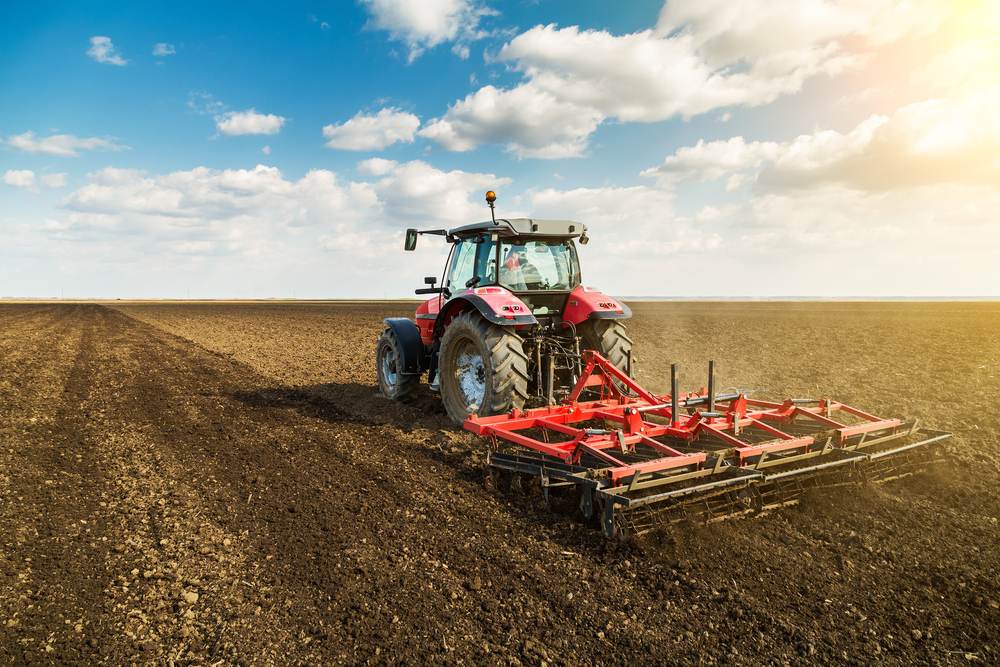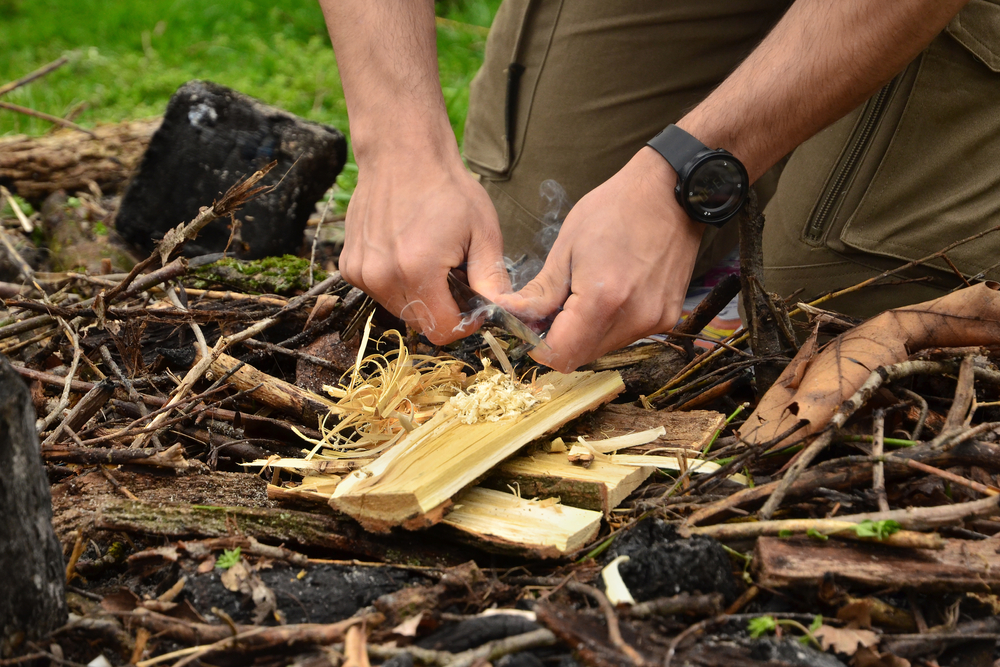The desire to own land has been moving the prepping and off-grid communities for generations. Having a few acres that give you room to do almost anything you can think of is a dream for many of us. Even more, achieving self-sufficiency on such a lot, and having a large pond or a small woodlot, is the ultimate life goal for some.
Owning half an acre or more provides you with endless possibilities when it comes to farming and you must become as efficient as possible to avoid wasting time and resources. With a large lot, you just won’t have the time to do everything you want, and you will keep yourself busy all day trying to cover everything that needs to be done.
Tools are needed
If you have a plot of land ranging from one to five acres, you will need certain tools to make your life easier. For example, a chainsaw can be used for both landscaping jobs and rough carpentry if needed.
If you plan to build a fence, you will need various tools to do the job right. A 13-pounds maul is an indispensable tool for wooden posts, and if you use fence wire, you’ll need wire stretchers.
The more fencing you have; the more work will be needed to keep vegetation from growing up in the fence lines. In such a case, a string trimmer becomes mandatory to clear the weeds.
Pulling and lifting jobs become impossible chores without a hand winch, a tool that becomes indispensable at times.
A sturdy barn
As time goes by, you will acquire more and more tools, and you’ll find that a barn will become the ideal place to store all those tools. Even more, it will keep feed dry, it can host machinery and protect it from the elements, and it can accommodate your livestock. It can host a milking parlor for goats and pretty much all the utilities you can think of.
Most people go with the two-story, gable-roofed barn since this design passed the efficiency and time-lasting tests. Some folks incorporate their chicken coop into their barn, especially if one side of the building provides access to a pasture area. Also, keep in mind that your barn should be connected to a corral. By doing so, you will be able to move livestock between pens but also load them into a truck with ease.
Building a barn is not easy since you’re dealing with a large construction project, and it becomes a major responsibility. Your barn needs to be strong enough to hold a heavy load in the upper loft and be able to also keep the elements out.
When you decide to build a barn, look up the term “pole barns” since these empty shells can be erected for a reasonable price. Once you have the framework up and the roof in place, you will also be able to work on the rest of the barn as time and budget allow it.
Building a greenhouse
Plastic sheeting, matched with plastic plumbing pipes and some scrap wood, allows you to build a cheap, small greenhouse that can host all your bedding plants and the seedlings you plan on selling.
There are all sorts of DIY YouTube videos that show you how to build inexpensive greenhouses. Having a greenhouse allows you to start the growing season early if you start your plants inside that greenhouse. It will also allow you to start potted plants, bedding plants, and pretty much anything you can think of without worrying about the late frost.
Using your land efficiently
Having five acres provides you with the opportunity to take on just about any agricultural project you want. You will also be able to experiment with various projects, and you will discover that some will have greater success than others.
Having enough room allows you to experiment with different animals, crops, and various ways to monetize your operations. You will soon discover which works best for your situation and how much time you must spend to achieve a successful backyard farm.
Setting a pasture
Some of the acreages on your farm should be used to establish a pasture for large meat-producing animals such as small cattle, pigs, sheep, alpacas. Anything other than chicken and rabbits could feed off this pasture.
The tricky thing with pastures is establishing how much pasture you allow per animal. This means that any given area can support a maximum number of animals. If you have a real winter with heavy frost and temperatures below the freezing point, for example, you will need to supplement your animals’ diet with hat, grains, or meal.
The quality of your pasture also impacts the number of animals it can sustain. To establish how good the land in your area is, you should ask local farmers for their opinions. Those with experience will be able to provide you with tips on how to increase the soil quality, what works best, and what doesn’t.
Planting an orchard
Planting an orchard can bring you a good profit and provide you with more fruits than you could eat. However, the trick here is to establish which trees to plant. Plus, you should know that people have switched from standard-sized trees to dwarf fruit trees in recent years. They are doing so since it was established that you could get more fruit from such small trees, and you also cut corners on having to buy ladders and other equipment needed to pick the fruit.
A one-acre orchard can host around 100 standard-sized fruit trees that will bear fruit in five years. On the other hand, you could have between 400 to 600 dwarf fruit trees on that same acre, and they will bear fruit starting with the second or third year.
Establishing a woodlot
Growing your own woodlot from scratch isn’t very practical, and it takes time, even if you plant fast-growing species. Even more, you should consider that the trees with the best firewood or those used in furniture manufacturing are usually the slowest growing ones.
However, if you already have a stand of timber on the land you bought, you can improve its growth, and in return, you will get some free firewood. Before deciding if you want to heat your home using only firewood, you must establish how well insulated your home is, how the climate in your area will affect your wood supply, and how efficient your wood burner is.
Also, you should consider the growth rate and the actual burning rate of the various species of trees available on your lot. To get a general idea of how much land is needed to grow your own firewood, you can establish how much wood you are using per year and compare that number with the standing timber you currently have on your property.
Growing feed
If you have more than one acre of land, you can establish a feed growing area in which corn, sorghum cane, and other animal feeds can be grown. How much feed you can obtain from one acre is subjected to different variables, but you can keep in mind that the national field corn production average is between 110 and 150 bushels per acre.
If you manage to successfully grow your own feed, you’ll need a place to store it. So, here is where that barn comes into play.
Traditionally, field corn is kept in whole ears in corncribs, and smaller grains are kept in large cans or sacks. Sorghum cane is made into silage (high moisture fermented feed) by packing it into plastic bags and letting anaerobic fermentation do the work. Some folks also opt for silage instead of hay since it is much more nutritious for their livestock, so you might want to consider this option as well.
Some homesteaders grow beets as livestock feed since they hold their nutrients well during storage. But you have to consider that growing and harvesting beets is a much more sustained effort compared to other feed crops.
Creating a pond
A pond is usually a body of water that is smaller than a lake, and digging one is not as expensive as some folks believe, considering the benefits you get for the rest of your life. You can hire heavy equipment for the day and have a decent-sized pond dug in one day’s time.
So, eight hours will be pretty much all the time you need to have your pond built. However, you must make sure you have clay-like soil in the area where you plan to create the pond; otherwise, you will have to line it with plastic or bentonite clay.
Also, consider that your land needs enough slope so that rain runoff can be diverted and keep your pond full. Once you have it filled with rainwater, you also have to stock it with fish and wait for the fish population to establish. Some large ponds won’t require feeding the fish, but in general, the fish will grow much faster if you take care of their needs in the first two years.
Raising small livestock
Establishing a pasture allows you to keep a milk cow, but you have to figure out if your family is ready for a milk cow and if you can use that much milk. Instead of dealing with one or two milk cows (since some also decide to sell raw milk – which is a complicated endeavor), you could concentrate your efforts on smaller livestock like miniature cattle, sheep, and other animals.
Miniature cattle
Tiny bovines have gained a lot of popularity in the last decade since some are not taller than 36 inches, and they can be raised for milk and meat without having to deal with the issues encountered when raising full-sized cattle. They are easier to handle, and transport and they require a smaller area, being cheaper to feed.
Miniature cattle are the micro version of the most common cattle breeds such as Holstein, Angus, Jersey, Hereford, but also Longhorn and Brahman. They can provide the right amount of meat for your family, and as far as your milk needs go, a miniature Holstein can give up to 3 gallons of milk per day.
Sheep
Sheep will provide you with meat and milk and the valuable wool, which still remains the most used animal fiber on earth. If you decide to raise sheep, you should know that such animals require lush pastures and good fencing to contain them. Pastures for sheep are generally a mix of grass, forbs, and clover, but your sheep can also eat grains and hay. They also need clean, fresh water and an open-front shed.
To establish how many sheep you can raise, you can use the old rule stating that eight sheep can be raised on the land needed by one Jersey cow. Also, since you will use manure as fertilizer, you should know that one sheep can produce more than a ton of manure per year, and in general, sheep manure is a much better fertilizer compared to cattle manure.
One alternative for your animal fiber-producing project would be to raise alpacas. The value of alpaca fiber is unmatched due to its similarity to wool but also because it’s less itch and has hypoallergenic properties. You can go with the Suri breed with long and straight hair or pick the Huacaya breed with wooly and dense hair.
Pigs
Many Americans love pork meat, and everyone I’ve met so far loves bacon. That being said, you should know that swine can be raised successfully, even in very small areas, in a humane manner. That is, of course, if you don’t have close neighbors that could be bothered by your meat production mission.
Some farm-friendly communities will allow you to grow everything except pigs since they “smell bad.” However, this is a misconception, and pigs are usually clean animals if they are not crammed together in small spaces. Pen pigs stand up to their reputation in terms of smell and cleanliness, so free-range pigs (pigs raised on pastures and in woodlands) may be the way to go if you have the available space.
Helpful machinery to consider
No backyard farm is complete without a few helpful machines that make all chores much easier. Here are some options you should consider if you embark on such a project.
Tractor
Tractors come in all sizes and shapes (although they do look alike), and there are clear distinctions between a small tractor and, let’s say, a riding lawnmower. Your riding lawn mower has a single purpose (mowing the lawn), and it usually has about three speeds forward. On the other hand, a small tractor can have between four and ten speeds forward, hydraulics, a three-point hitch, and a heavy-duty build that should last for a lifetime (ideally).
Small tractors can be used to pull trailers full of heavy things, and they have gears for various tasks. Some of the more popular implements are plow, grader blade, mower, bush-hog, log splitter, loader, and post-hole auger.
Tractors provide you with many options, and you can do a lot of jobs that you won’t consider until the time to do so comes. They are well-built, and they aren’t cheap since they are considered universal pieces of machinery or tools. That said, you can opt for a good used tractor if money is a problem.
If you have five acres or less, you can also go with a smaller tractor, and you can pick an import one from Japan, Korea, China, or India. Or you can look for an old Ford N-serries. Even so, there are pros and cons to each.
The import ones are newer and more modern and have various features such as very low range transmissions and many forward speeds, modern hydraulics, and a four-wheel-drive system that will prove quite handy. However, the more complex they are, the harder it will be to fix them.
On the other hand, the Ford N-series are much simpler, and they allow you to fix almost everything yourself, provided you have the owner’s manual and the wits to do it. Even if the Fords are old models, there are many out there in perfect running condition, and their simplicity in design makes them a great purchase. Parts are cheap and easy to install, and you can get a good used one for half the price you will pay for an import one.
Two-wheel tractor
These little machines are known in popular terms as “walk-behind tractors” and can till up a heavy garden in short order with little input from the operator. These are the perfect machines if you have ground to till, and they can perform other jobs as well, provided you have the proper attachments. For example, you can blow snow using a two-wheel tractor, or you can pull carts loaded with heavy items.
Skid-steer loader
You can also find a small skid loader on many farms since these machines do not require steering like tractors, and they can pivot by breaking one side or the other. They are extremely useful and easy to operate in close quarters since they can turn around at their own length.
Let’s say you need to move and place something within an inch or so of a certain area. Using a tractor requires complex maneuvers to do the job right but using a skid loader will make working in one spot a precise and fast operation.
And just like tractors, such types of machinery have all sorts of available implements that will fit on the front. This alone makes them ideal for lifting and moving things. They can do various bulldozer-like jobs if they are equipped with the proper implements, and some people will even dig their own ponds using nothing more than a skid-steer loader. You can also find implements such as tree shears, stump grinders, buckets, and grapples for your loaders.
Even more, these are the preferred machines and a treasured investment for those farming in their late years since they can handle a lot of lifting and portability tasks.
Concluding
Farming on a large plot of land offers a lot of opportunities, but one also needs to plan things ahead before the heavy lifting starts. Each project will have its ups and downs, and some will prove to be most rewarding and minimize the failure of the less successful ones.
Having the right tools and the proper knowledge to use them to handle various jobs also becomes mandatory on a large farm. You will spend your time more efficiently, and you will be able to take care of more and more tasks if you have the tools that can replace manual labor. The possibilities are endless, but you need to consider your abilities and limitations when farming on a large lot.























































































Wnere do you find the dwarf trees? And how do you know which variety is best?
Really so good. This farming must be so hard. But I guess they will have a lot of agricultural products.
Unless you’re in zone 6 or higher, DO NOT plant dwarf trees. The rootstock will not be hardy enough to allow the plant to thrive or in some cases even survive. Semi-dwarfs can be grown to zone 5. One other thing to consider is even a tree that is rated to zone 3 if it was grown in zone 5 it also might not thrive or even winterkill. Buy trees grown in the same zone as where they’ll be planted. A good source is St. Lawrence Nurseries. No connection with them, just a happy customer.